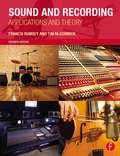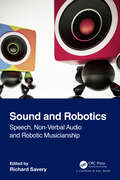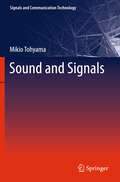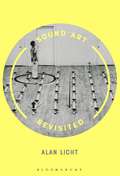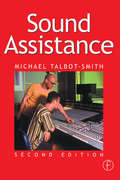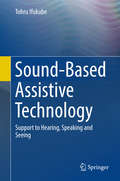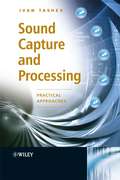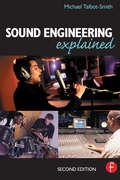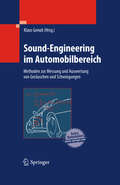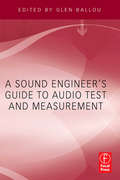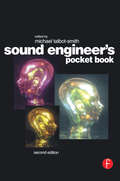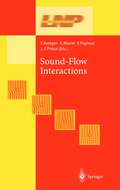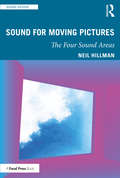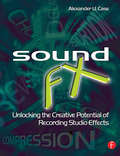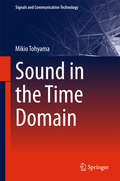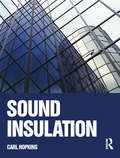- Table View
- List View
Sound and Recording: Applications and Theory
by Francis Rumsey Tim McCormickProviding vital reading for audio students and trainee engineers, this guide is ideal for anyone who wants a solid grounding in both theory and industry practices in audio, sound and recording. There are many books on the market covering "how to work it" when it comes to audio equipment—but Sound and Recording isn’t one of them. Instead, you’ll gain an understanding of "how it works" with this approachable guide to audio systems. New to this edition: Digital audio section revised substantially to include the latest developments in audio networking (e.g. RAVENNA, AES X-192, AVB), high-resolution surround and parametric audio coding, workstation processing technology, mastering for iTunes, and loudness normalization Coverage of immersive audio systems such as Dolby Atmos, Auro 3D and WFS along with recent developments in audio object coding Sections on digital radio microphones, loudspeaker sensitivity issues and development, and highly directional loudspeaker systems Substantial new sections on recent developments in audio network device discovery and control and the Open Control Architecture
Sound and Robotics: Speech, Non-Verbal Audio and Robotic Musicianship
by Richard SaverySound in human–robot interaction currently encompasses a wide range of approaches and methodologies not easily classified, analyzed or compared among projects. This edited book covers the state of the art in sound and robotics, aiming to gather existing approaches in a combined volume. Collecting chapters from world-leading academic and industry authors, Sound and Robotics: Speech, Non-Verbal Audio and Robotic Musicianship explores how robots can communicate through speech, non-verbal audio and music. The first set of chapters explores how robots use verbal communication, considering the possibilities of speech for human–robot interaction. The second section shifts to roles of non-verbal communication in HRI, including consequential sound, sonification and audio cues. The third and final section describes current approaches to robotic musicianship and their evaluation. This book is primarily aimed at HRI researchers, ranging from those who have never used sound to those very experienced with sound. Alongside robotic researchers, this book will present avenues for a diverse range of musicians, composers and sound designers to become introduced to the world of HRI and learn of potential creative directions in robotics.
Sound and Robotics: Speech, Non-Verbal Audio and Robotic Musicianship
Sound in human–robot interaction currently encompasses a wide range of approaches and methodologies not easily classified, analyzed or compared among projects. This edited book covers the state of the art in sound and robotics, aiming to gather existing approaches in a combined volume. Collecting chapters from world-leading academic and industry authors, Sound and Robotics: Speech, Non-Verbal Audio and Robotic Musicianship explores how robots can communicate through speech, non-verbal audio and music. The first set of chapters explores how robots use verbal communication, considering the possibilities of speech for human–robot interaction. The second section shifts to roles of non-verbal communication in HRI, including consequential sound, sonification and audio cues. The third and final section describes current approaches to robotic musicianship and their evaluation. This book is primarily aimed at HRI researchers, ranging from those who have never used sound to those very experienced with sound. Alongside robotic researchers, this book will present avenues for a diverse range of musicians, composers and sound designers to become introduced to the world of HRI and learn of potential creative directions in robotics.
Sound and Signals (Signals and Communication Technology)
by Mikio TohyamaThis is an up-to-date reference and textbook on modern acoustics from a signal-theoretic point of view, as well as a wave-theoretic approach for students, engineers, and researchers. It provides readers the fundamental basis of acoustics and vibration science and proceeds up to recent hot topics related to acoustic transfer functions and signal analysis including a perceptual point of view.In the first part, the work uniquely introduces into the fundamentals without using heavy mathematics The following, advanced chapters deal with new and deep insights into acoustic signal analysis and investigation of room transfer functions based on the poles and zeros.
Sound Art Revisited
by Alan LichtThe first edition of Sound Art Revisited (published as Sound Art: Beyond Music, Between Categories) served as a groundbreaking work toward defining this emerging field, and this fully updated volume significantly expands the story to include current research since the book's initial release. Viewed through a lens of music and art histories rather than philosophical theory, it covers dozens of artists and works not found in any other book on the subject. Locating sound art's roots across the centuries from spatialized church music to the technological developments of radio, sound recording, and the telephone, the book traces the evolution of sound installations and sound sculpture, the rise of sound art exhibitions and galleries, and finally looks at the critical cross-pollination that marks some of the most important and challenging art with and about sound being produced today.
Sound Art Revisited
by Alan LichtThe first edition of Sound Art Revisited (published as Sound Art: Beyond Music, Between Categories) served as a groundbreaking work toward defining this emerging field, and this fully updated volume significantly expands the story to include current research since the book's initial release. Viewed through a lens of music and art histories rather than philosophical theory, it covers dozens of artists and works not found in any other book on the subject. Locating sound art's roots across the centuries from spatialized church music to the technological developments of radio, sound recording, and the telephone, the book traces the evolution of sound installations and sound sculpture, the rise of sound art exhibitions and galleries, and finally looks at the critical cross-pollination that marks some of the most important and challenging art with and about sound being produced today.
Sound Assistance
by Michael Talbot-SmithSound Assistance offers a highly readable and easy-to-understand account of sound operations in radio and television studios. By knowing the characteristics of the equipment, such as threshold and compression ratios, it is much easier to achieve professional effects quickly, saving hours of trial and error. The book will suit anyone wishing to work as a sound assistant but who does not have a thorough grounding in the maths and physics. Written in an informal style with practical 'do's' and 'don'ts', the fundamental principles are explained. Where knowledge of a higher level of maths is helpful, this information is given in handy 'fact files'.Particularly appropriate for students, training officers and supervisors who have the task of passing on this information in a simple, easy-to-digest format, Sound Assistance is written in easy-to read language with a minimum of maths.This second edition now has more on:* Microphone sensitivities* Loudspeaker listening tests* Domestic colour code for stereo* Stereo transmission in radio* Stereo PPM interpretations* MiniDisk* Digital radio* Recordable CDs.Michael Talbot-Smith is a freelance audio consultant and author of Audio Explained, and coauthor of The Video Studio. He is editor of The Audio Engineer's Reference Book (now in its second edition) and The Sound Engineer's Pocketbook. He is a former trainer of audio engineers at BBC Wood Norton.
Sound Assistance
by Michael Talbot-SmithSound Assistance offers a highly readable and easy-to-understand account of sound operations in radio and television studios. By knowing the characteristics of the equipment, such as threshold and compression ratios, it is much easier to achieve professional effects quickly, saving hours of trial and error. The book will suit anyone wishing to work as a sound assistant but who does not have a thorough grounding in the maths and physics. Written in an informal style with practical 'do's' and 'don'ts', the fundamental principles are explained. Where knowledge of a higher level of maths is helpful, this information is given in handy 'fact files'.Particularly appropriate for students, training officers and supervisors who have the task of passing on this information in a simple, easy-to-digest format, Sound Assistance is written in easy-to read language with a minimum of maths.This second edition now has more on:* Microphone sensitivities* Loudspeaker listening tests* Domestic colour code for stereo* Stereo transmission in radio* Stereo PPM interpretations* MiniDisk* Digital radio* Recordable CDs.Michael Talbot-Smith is a freelance audio consultant and author of Audio Explained, and coauthor of The Video Studio. He is editor of The Audio Engineer's Reference Book (now in its second edition) and The Sound Engineer's Pocketbook. He is a former trainer of audio engineers at BBC Wood Norton.
Sound-Based Assistive Technology: Support to Hearing, Speaking and Seeing
by Tohru IfukubeThis book presents a technology to help speech-, hearing- and sight-impaired people. It explains how they will benefit from an enhancement in their ability to recognize and produce speech or to detect sounds in their surroundings. Additionally, it is considered how sound-based assistive technology might be applied to the areas of speech recognition, speech synthesis, environmental recognition, virtual reality and robots. The primary focus of this book is to provide an understanding of both the methodology and basic concepts of assistive technology rather than listing the variety of assistive devices developed. This book presents a number of different topics which are sufficiently independent from one another that the reader may begin at any chapter without lacking background information. Much of the research quoted in this book was conducted in the author's laboratories at Hokkaido University and University of Tokyo. This book offers the reader a better understanding of a number of unsolved problems that still persist in the field of sound-based assistive technology.
Sound Capture and Processing: Practical Approaches
by Ivan Jelev TashevProvides state-of-the-art algorithms for sound capture, processing and enhancement Sound Capture and Processing: Practical Approaches covers the digital signal processing algorithms and devices for capturing sounds, mostly human speech. It explores the devices and technologies used to capture, enhance and process sound for the needs of communication and speech recognition in modern computers and communication devices. This book gives a comprehensive introduction to basic acoustics and microphones, with coverage of algorithms for noise reduction, acoustic echo cancellation, dereverberation and microphone arrays; charting the progress of such technologies from their evolution to present day standard. Sound Capture and Processing: Practical Approaches Brings together the state-of-the-art algorithms for sound capture, processing and enhancement in one easily accessible volume Provides invaluable implementation techniques required to process algorithms for real life applications and devices Covers a number of advanced sound processing techniques, such as multichannel acoustic echo cancellation, dereverberation and source separation Generously illustrated with figures and charts to demonstrate how sound capture and audio processing systems work An accompanying website containing Matlab code to illustrate the algorithms This invaluable guide will provide audio, R&D and software engineers in the industry of building systems or computer peripherals for speech enhancement with a comprehensive overview of the technologies, devices and algorithms required for modern computers and communication devices. Graduate students studying electrical engineering and computer science, and researchers in multimedia, cell-phones, interactive systems and acousticians will also benefit from this book.
Sound Engineering Explained
by Michael Talbot-SmithThis straightforward introduction to audio techniques guides the beginner through principles such as sound waves and basic acoustics and offers practical advice for using recording and reproduction equipment. Previously known as Audio Explained, this latest edition includes new material on: reverberation and its use in recording; principles of digital mixing; digital recording; including MiniDisc and MP3; digital artificial reverberation. Designed with the student in mind, information is organised according to level of difficulty. An understanding of the basic principles is essential to anyone wishing to make successful recordings and so chapters are split into two parts: the first introducing the basic theories in a non-technical way; the second dealing with the subject in more depth. Key facts are clearly identified in separate boxes and further information for the more advanced reader is indicated in shaded boxes. In addition, questions are provided (with answers supplied at the end of the book) as a teaching and learning aid.Sound Engineering Explained is ideal for both serious audio amateurs any student studying audio for the first time, in particular those preparing for Part One exams of the City & Guilds Sound Engineering (1820) course.
Sound Engineering Explained
by Michael Talbot-SmithThis straightforward introduction to audio techniques guides the beginner through principles such as sound waves and basic acoustics and offers practical advice for using recording and reproduction equipment. Previously known as Audio Explained, this latest edition includes new material on: reverberation and its use in recording; principles of digital mixing; digital recording; including MiniDisc and MP3; digital artificial reverberation. Designed with the student in mind, information is organised according to level of difficulty. An understanding of the basic principles is essential to anyone wishing to make successful recordings and so chapters are split into two parts: the first introducing the basic theories in a non-technical way; the second dealing with the subject in more depth. Key facts are clearly identified in separate boxes and further information for the more advanced reader is indicated in shaded boxes. In addition, questions are provided (with answers supplied at the end of the book) as a teaching and learning aid.Sound Engineering Explained is ideal for both serious audio amateurs any student studying audio for the first time, in particular those preparing for Part One exams of the City & Guilds Sound Engineering (1820) course.
Sound-Engineering im Automobilbereich: Methoden zur Messung und Auswertung von Geräuschen und Schwingungen
by Klaus GenuitMit steigenden Kundenansprüchen gewinnen die Fragen unerwünschter Geräusche im Kraftfahrzeug zunehmend an Bedeutung. Sie begleiten Ingenieure im Automobilbereich von der Konzept- bis zur Serienphase. Dabei ist das Thema stets im Kontext weiterer Entwicklungsfelder wie Antrieb oder Aerodynamik zu betrachten. Das Überblickswerk bietet die Möglichkeit, sich schnell in das Thema einzuarbeiten und schnell auf Grundlagen und Details zugreifen zu können. Dabei werden die Themen Fahrzeuginnengeräusche und Fahrzeugaußengeräusche gleichermaßen behandelt.
A Sound Engineers Guide to Audio Test and Measurement
by Glen BallouThis book offers a quick guide and complete reference to the fundamentals of test and measurement for all aspects of sound engineering.Including electrical and acoustic testing, measurement systems, levels, methods, protecting the ear, units of measurement and standards, this guide comes with and multiple tables to ensure quick easy access to information and illustrate points this is a must have reference for all audio engineers.
A Sound Engineers Guide to Audio Test and Measurement
by Glen BallouThis book offers a quick guide and complete reference to the fundamentals of test and measurement for all aspects of sound engineering.Including electrical and acoustic testing, measurement systems, levels, methods, protecting the ear, units of measurement and standards, this guide comes with and multiple tables to ensure quick easy access to information and illustrate points this is a must have reference for all audio engineers.
Sound Engineer's Pocket Book
by Michael Talbot-SmithA handy source of essential data that every sound technician needs. Whether you are a professional sound engineer, responsible for broadcast or studio recording, or a student on a music technology or sound recording course, you will find this book authoritative and easily accessible. Adapted from the comprehensive volume, the Audio Engineer's Reference Book (now in its second edition), this pocket-sized reference has been fully revised to cover the very latest technology connected with sound:Noise measurement AcousticsMicrophonesLoudspeakersMixing equipmentCDs, DAT, MIDI, MiniDisc TelephonyISDNDigital interfacingUltrasonics This second edition also features:Substantial revisions of chapters on radio microphone frequencies, digital audio tape, and audio measurements.An extended list of further reading.
Sound Engineer's Pocket Book
by Michael Talbot-SmithA handy source of essential data that every sound technician needs. Whether you are a professional sound engineer, responsible for broadcast or studio recording, or a student on a music technology or sound recording course, you will find this book authoritative and easily accessible. Adapted from the comprehensive volume, the Audio Engineer's Reference Book (now in its second edition), this pocket-sized reference has been fully revised to cover the very latest technology connected with sound:Noise measurement AcousticsMicrophonesLoudspeakersMixing equipmentCDs, DAT, MIDI, MiniDisc TelephonyISDNDigital interfacingUltrasonics This second edition also features:Substantial revisions of chapters on radio microphone frequencies, digital audio tape, and audio measurements.An extended list of further reading.
Sound-Flow Interactions (Lecture Notes in Physics #586)
by Y. Auregan A. Maurel V. Pagneux J. F. PintonSound for Moving Pictures: The Four Sound Areas (Sound Design)
by Neil HillmanSound for Moving Pictures presents a new and original sound design theory called the Four Sound Areas framework, offering a conceptual template for constructing, deconstructing and communicating all types of motion picture soundtracks; and a way for academics and practitioners to better understand and utilize the deeper, emotive capabilities available to all filmmakers through the thoughtful use of sound design. The Four Sound Areas framework presents a novel approach to sound design that enables the reader to more fully appreciate audience emotions and audience engagement, and provides a flexible, practical model that will allow professionals to more easily create and communicate soundtracks with greater emotional significance and meaning. Of obvious benefit to sound specialists, as well as motion picture professionals such as film producers, directors and picture editors, Sound for Moving Pictures also provides valuable insight for others interested in the subject; such as those involved with teaching soundtrack analysis, or those researching the wider topics of film studies and screen writing.
Sound for Moving Pictures: The Four Sound Areas (Sound Design)
by Neil HillmanSound for Moving Pictures presents a new and original sound design theory called the Four Sound Areas framework, offering a conceptual template for constructing, deconstructing and communicating all types of motion picture soundtracks; and a way for academics and practitioners to better understand and utilize the deeper, emotive capabilities available to all filmmakers through the thoughtful use of sound design. The Four Sound Areas framework presents a novel approach to sound design that enables the reader to more fully appreciate audience emotions and audience engagement, and provides a flexible, practical model that will allow professionals to more easily create and communicate soundtracks with greater emotional significance and meaning. Of obvious benefit to sound specialists, as well as motion picture professionals such as film producers, directors and picture editors, Sound for Moving Pictures also provides valuable insight for others interested in the subject; such as those involved with teaching soundtrack analysis, or those researching the wider topics of film studies and screen writing.
Sound FX: Unlocking the Creative Potential of Recording Studio Effects
by Alex CaseFX introduces today's up and coming musician to the fantastic creative potential of the most popular instrument today- the home studio. Explaining the basic and advanced signal processing techniques used in professional music production (EQ, compression, delay, reverb etc), using real world popular music examples and an emphasis on the perceptual results and musical value of these effects, FX teaches the Recording Musician how to achieve professional production standards and maximise their creative potential. The accompanying website www.soundfx-companion.com includes audio exaples of FX featured in the book.Features: A chapter dedicated to each key effect: Distortion Equalization Compression and Limiting Delay Expansion and Gating Pitch Shift Reverb Volume More than 100 line drawings and illustrations. Accompanying website featuring examples of all FX covered in the book. Discography of FX at the end of each relevant chapter. From the Sound FX Intro: The most important music of our time is recorded music. The recording studio is its principle musical instrument. The recording engineers and music producers who create the music we love know how to use signal processing equipment to capture the work of artists, preserving realism or altering things wildly, as appropriate. While the talented, persistent, self-taught engineer can create sound recordings of artistic merit, more productive use of the studio is achieved through study, experience and collaboration. This book defines the technical basis of the most important signal processing effects used in the modern recording studio, highlights the key drivers of sound quality associated with each, shares common production techniques used by recording engineers with significant experience in the field, references many of the touchstone recordings of our time, and equips the reader with the knowledge needed to comfortably use effects devices correctly, and, more importantly, to apply these tools creatively.
Sound FX: Unlocking the Creative Potential of Recording Studio Effects
by Alex CaseFX introduces today's up and coming musician to the fantastic creative potential of the most popular instrument today- the home studio. Explaining the basic and advanced signal processing techniques used in professional music production (EQ, compression, delay, reverb etc), using real world popular music examples and an emphasis on the perceptual results and musical value of these effects, FX teaches the Recording Musician how to achieve professional production standards and maximise their creative potential. The accompanying website www.soundfx-companion.com includes audio exaples of FX featured in the book.Features: A chapter dedicated to each key effect: Distortion Equalization Compression and Limiting Delay Expansion and Gating Pitch Shift Reverb Volume More than 100 line drawings and illustrations. Accompanying website featuring examples of all FX covered in the book. Discography of FX at the end of each relevant chapter. From the Sound FX Intro: The most important music of our time is recorded music. The recording studio is its principle musical instrument. The recording engineers and music producers who create the music we love know how to use signal processing equipment to capture the work of artists, preserving realism or altering things wildly, as appropriate. While the talented, persistent, self-taught engineer can create sound recordings of artistic merit, more productive use of the studio is achieved through study, experience and collaboration. This book defines the technical basis of the most important signal processing effects used in the modern recording studio, highlights the key drivers of sound quality associated with each, shares common production techniques used by recording engineers with significant experience in the field, references many of the touchstone recordings of our time, and equips the reader with the knowledge needed to comfortably use effects devices correctly, and, more importantly, to apply these tools creatively.
Sound in the Time Domain (Signals and Communication Technology)
by Mikio TohyamaThis book addresses the nature of sound, focusing on the characteristics of sound waves in the context of time structures. This time domain approach provides an informative and intuitively understandable description of various acoustic topics such as sound waves travelling in an acoustic tube or in other media where spectral or modal analysis can be intensively performed. Starting from the introductory topic of sinusoidal waves, it discusses the formal relationship between the time and frequency domains, summarizing the fundamental notions of Fourier or z-transformations and linear systems theory, along with interesting examples from acoustical research. The books novel approach is of interest to research engineers and scientists In particular, the expressions concerning waveforms including the impulse responses are important for audio engineers who are familiar with digital signal analysis. Every chapter includes simple exercises designed to be solved without the need for a computer. Thus they help reconfirm the fundamental ideas and notions present in every chapter. The book is self-contained and concise, and requires only basic knowledge of acoustics and signal processing, making it valuable as a textbook for graduate and undergraduate university courses.
Sound Insulation
by Carl HopkinsSound insulation is an important aspect of building performance. This book is a comprehensive guide to sound and vibration theory and its application to the measurement and prediction of sound insulation in buildings. It enables the reader to tackle a wide range of issues relating to sound insulation during the design and construction stages of a building, and to solve problems in existing buildings. The book has been written for engineers, consultants, building designers, students in acoustics, researchers and those involved in the manufacture and design of building products. Key aspects are that it:* Explains the fundamental theory using examples that show its direct application to buildings* Guides the reader through the links between measurement and theory* Explains concepts that are important for the application, interpretation and understanding of guidance documents, test reports, product data sheets, published papers, regulations and Standards* Makes direct reference to ISO and EN Standards on sound insulation* Contains a large number of illustrations showing measurements, predictions and example calculations for quick referenceCarl Hopkins previously worked on building acoustics and environmental noise at the Building Research Establishment. During this time he was involved with sound insulation in research, consultancy, standardization, and building regulations as well as being an advisor on acoustics to government departments. He is currently a Senior Lecturer at the University of Liverpool within the Acoustics Research Unit of the School of Architecture.
Sound Insulation
by Carl HopkinsSound insulation is an important aspect of building performance. This book is a comprehensive guide to sound and vibration theory and its application to the measurement and prediction of sound insulation in buildings. It enables the reader to tackle a wide range of issues relating to sound insulation during the design and construction stages of a building, and to solve problems in existing buildings. The book has been written for engineers, consultants, building designers, students in acoustics, researchers and those involved in the manufacture and design of building products. Key aspects are that it:* Explains the fundamental theory using examples that show its direct application to buildings* Guides the reader through the links between measurement and theory* Explains concepts that are important for the application, interpretation and understanding of guidance documents, test reports, product data sheets, published papers, regulations and Standards* Makes direct reference to ISO and EN Standards on sound insulation* Contains a large number of illustrations showing measurements, predictions and example calculations for quick referenceCarl Hopkins previously worked on building acoustics and environmental noise at the Building Research Establishment. During this time he was involved with sound insulation in research, consultancy, standardization, and building regulations as well as being an advisor on acoustics to government departments. He is currently a Senior Lecturer at the University of Liverpool within the Acoustics Research Unit of the School of Architecture.
